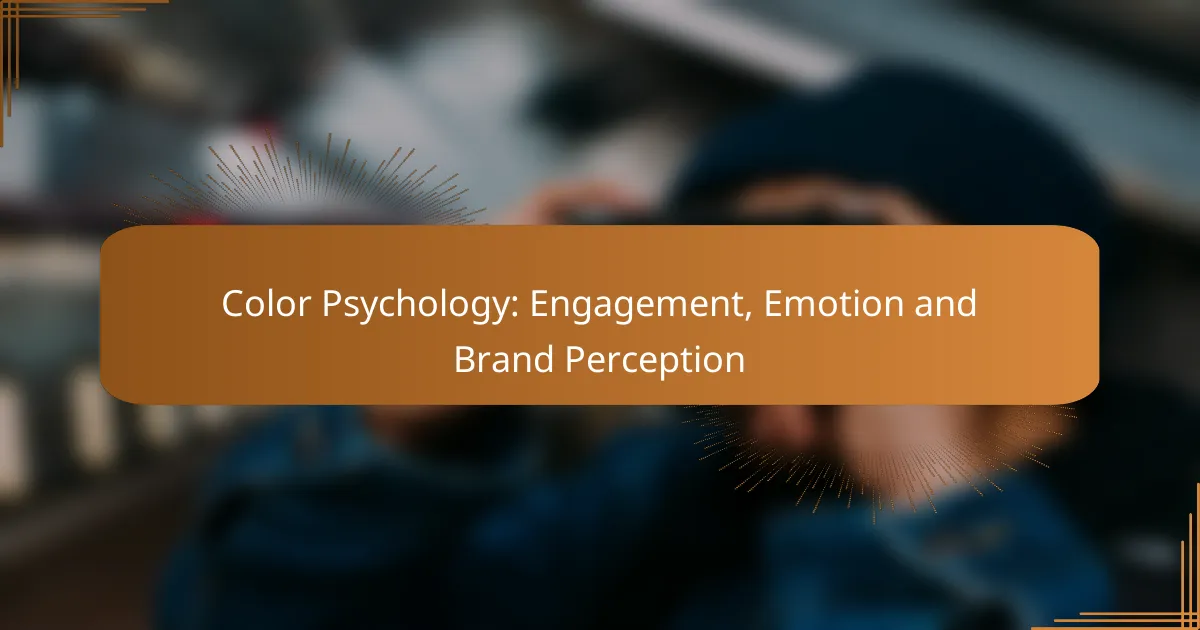Typography is a powerful tool that shapes readability and influences brand voice in digital advertising. By selecting the right fonts and styles, brands can enhance user experience and convey their messages effectively, ensuring clarity in a competitive landscape. In 2023, trends emphasize boldness and minimalism, aligning visual identity with brand values while maintaining functionality across various platforms.

How does typography impact readability in digital advertising?
Typography significantly influences readability in digital advertising by affecting how easily viewers can process text. Effective typography enhances user experience, ensuring that messages are conveyed clearly and quickly, which is crucial for capturing attention in a crowded digital landscape.
Font choice affects legibility
The choice of font plays a critical role in legibility, which is essential for effective communication. Sans-serif fonts like Arial or Helvetica are often preferred for digital screens due to their clean lines and simplicity, making them easier to read at various sizes. In contrast, decorative fonts can detract from clarity, especially in smaller sizes.
When selecting a font, consider the target audience and the context of the advertisement. For instance, a modern tech brand might opt for a sleek sans-serif font, while a luxury brand may choose a serif font to convey elegance.
Line spacing enhances comprehension
Line spacing, or leading, is crucial for enhancing comprehension in digital text. Adequate spacing between lines helps prevent the text from appearing crowded, allowing readers to follow along more easily. A general guideline is to use line spacing that is 1.2 to 1.5 times the font size for optimal readability.
Too little line spacing can lead to visual fatigue, while excessive spacing may disrupt the flow of reading. Experimenting with different line heights can help find the right balance for your specific content and audience.
Contrast improves visibility
Contrast between text and background is vital for visibility in digital advertising. High contrast, such as black text on a white background, enhances readability, while low contrast can make text difficult to see. It’s recommended to maintain a contrast ratio of at least 4.5:1 for normal text to ensure accessibility.
Consider using color theory to select contrasting colors that align with your brand voice. Tools are available online to check contrast ratios, ensuring compliance with accessibility standards.
Size influences engagement
Text size directly influences user engagement and readability. Larger font sizes tend to attract more attention and are easier to read, especially on mobile devices. A common practice is to use a minimum font size of 16 pixels for body text to ensure clarity across various screen sizes.
Be mindful of the hierarchy in font sizes; headings should be significantly larger than body text to guide the reader through the content. This visual hierarchy helps users quickly identify key messages and improves overall engagement with the advertisement.

What typography styles enhance brand voice?
Typography styles play a crucial role in enhancing brand voice by influencing how a brand is perceived. Choosing the right font can evoke specific emotions and associations, aligning the visual identity with the brand’s message and values.
Serif fonts convey tradition
Serif fonts, characterized by their small decorative lines at the ends of letters, often evoke a sense of tradition and reliability. Brands that want to project a classic image, such as law firms or financial institutions, frequently use serif fonts to instill trust and authority.
When selecting a serif font, consider its readability and the context in which it will be used. Popular choices include Times New Roman and Georgia, which are well-suited for print and digital formats alike. However, avoid overly ornate serif fonts that may hinder legibility.
Sans-serif fonts suggest modernity
Sans-serif fonts lack the decorative lines found in serif fonts, giving them a clean and contemporary appearance. These fonts are often associated with innovation and simplicity, making them ideal for tech companies and startups aiming for a modern brand image.
Common sans-serif fonts include Arial and Helvetica, which are versatile for various applications. When using sans-serif fonts, ensure that the weight and spacing are balanced to maintain clarity, especially in digital formats where screen readability is paramount.
Display fonts create uniqueness
Display fonts are designed to stand out and capture attention, making them perfect for branding elements that require a unique flair. These fonts can range from playful to elegant, allowing brands to express their personality vividly.
When incorporating display fonts, use them sparingly for headlines or key messages to avoid overwhelming the audience. Examples include Lobster for a casual vibe or Didot for a more sophisticated look. Always ensure that the display font aligns with the overall brand voice and complements other typography choices.

Which typography trends are popular in 2023?
In 2023, typography trends emphasize flexibility, boldness, and minimalism to enhance readability and brand voice. These trends reflect a growing preference for designs that are not only visually appealing but also functional across various digital platforms.
Variable fonts for flexibility
Variable fonts allow designers to create a wide range of styles from a single font file, offering flexibility in weight, width, and slant. This adaptability can significantly reduce page load times and improve user experience by minimizing the number of font files needed.
When using variable fonts, consider the context in which they will be displayed. For instance, a variable font can be adjusted for different screen sizes, ensuring optimal readability on both mobile and desktop devices. Aim for a balance between aesthetic appeal and functional clarity.
Bold typography for emphasis
Bold typography is increasingly used to draw attention to key messages and enhance brand identity. This trend helps important information stand out, making it easier for users to scan content quickly.
To effectively use bold fonts, limit their application to headlines, calls to action, or critical information. Overusing bold type can lead to visual clutter, diminishing its impact. A good rule of thumb is to use bold for no more than 20% of your text to maintain clarity.
Minimalist designs for clarity
Minimalist typography focuses on simplicity and functionality, stripping away unnecessary elements to enhance readability. This trend aligns well with modern design principles, emphasizing clean lines and ample white space.
When implementing minimalist designs, choose sans-serif fonts for a contemporary look and ensure sufficient contrast between text and background. Keep text sizes consistent and avoid excessive embellishments to maintain a clear hierarchy and guide the reader’s eye effectively.
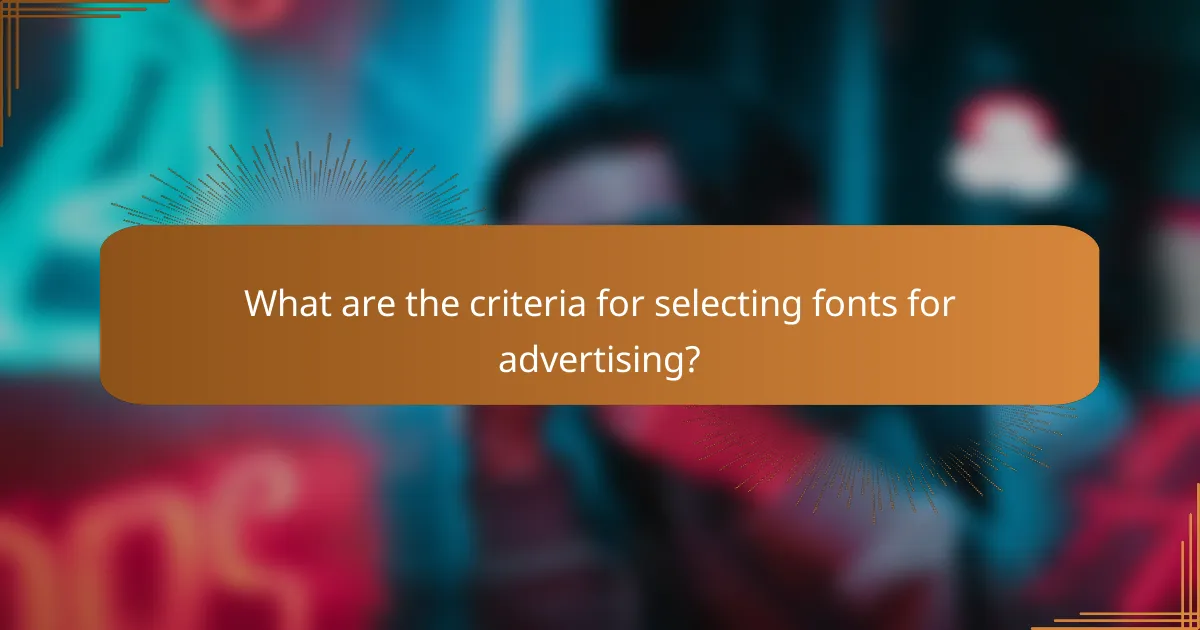
What are the criteria for selecting fonts for advertising?
Selecting fonts for advertising involves considering readability, style, and how well the font reflects the brand’s voice. The right font can enhance message clarity and resonate with the target audience, ultimately influencing consumer perception and engagement.
Target audience preferences
Understanding target audience preferences is crucial when choosing fonts for advertising. Different demographics may favor specific styles; for instance, younger audiences might prefer modern, sans-serif fonts, while older consumers may gravitate towards classic serif fonts. Conducting surveys or focus groups can provide insights into which font styles resonate best with your intended market.
Additionally, cultural factors can influence font preferences. For example, certain fonts may evoke specific emotions or associations in different regions, so it’s essential to consider the cultural context of your audience when making font selections.
Brand personality alignment
The selected font should align with the brand’s personality to create a cohesive identity. A playful brand might opt for rounded, whimsical fonts, while a luxury brand may choose elegant, serif fonts to convey sophistication. This alignment helps reinforce the brand’s message and values, making it more memorable to consumers.
To ensure alignment, create a font style guide that outlines the characteristics of your brand’s voice. This guide can serve as a reference for future advertising materials, ensuring consistency across all platforms and enhancing brand recognition.
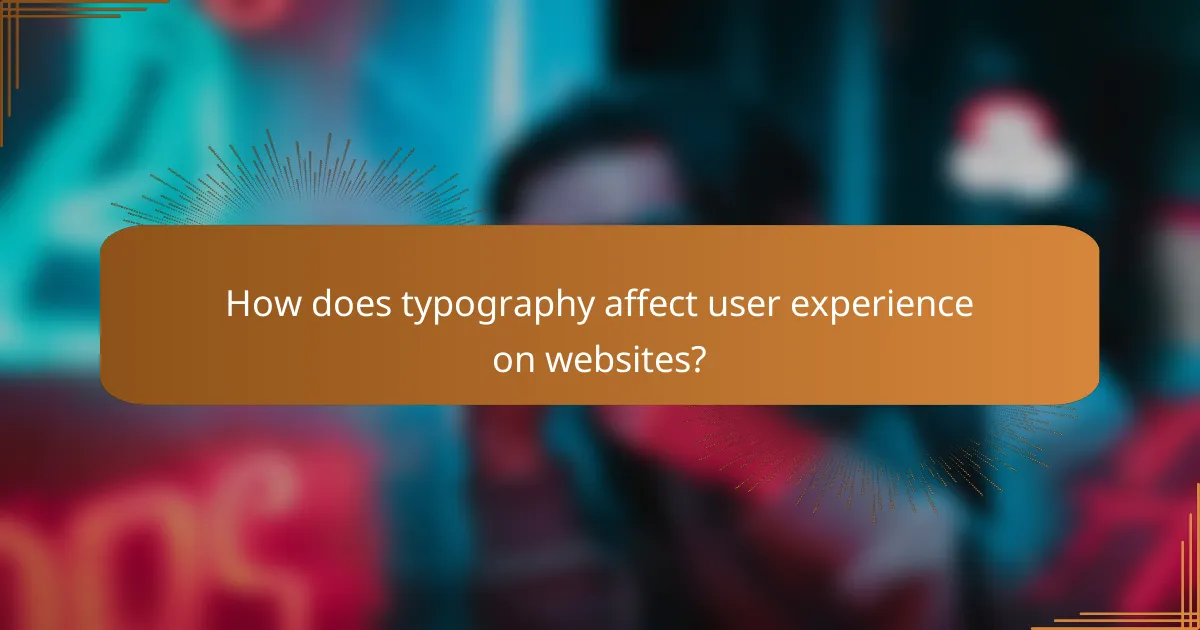
How does typography affect user experience on websites?
Typography significantly impacts user experience on websites by influencing how easily content can be read and understood. Effective typography enhances clarity, guides users through information, and reinforces brand identity.
Readability influences retention
Readability is crucial for retaining visitors on a website. When text is easy to read, users are more likely to engage with the content and remember key messages. Factors such as font choice, size, line spacing, and contrast all contribute to how readable text appears.
For optimal readability, consider using sans-serif fonts for digital content, as they are generally easier to read on screens. Aim for a font size of at least 16px and ensure there is sufficient contrast between the text and background colors. Avoid overly decorative fonts that can distract from the message.
Hierarchy guides navigation
Typography hierarchy helps users navigate a website by visually distinguishing different types of information. By using varying font sizes, weights, and styles, you can create a clear structure that guides users through headings, subheadings, and body text.
To establish a strong hierarchy, use larger, bolder fonts for main headings and smaller, lighter fonts for subheadings and body text. This approach allows users to quickly scan the page and locate relevant information. Consistency in typography across the site also reinforces this hierarchy and improves overall user experience.
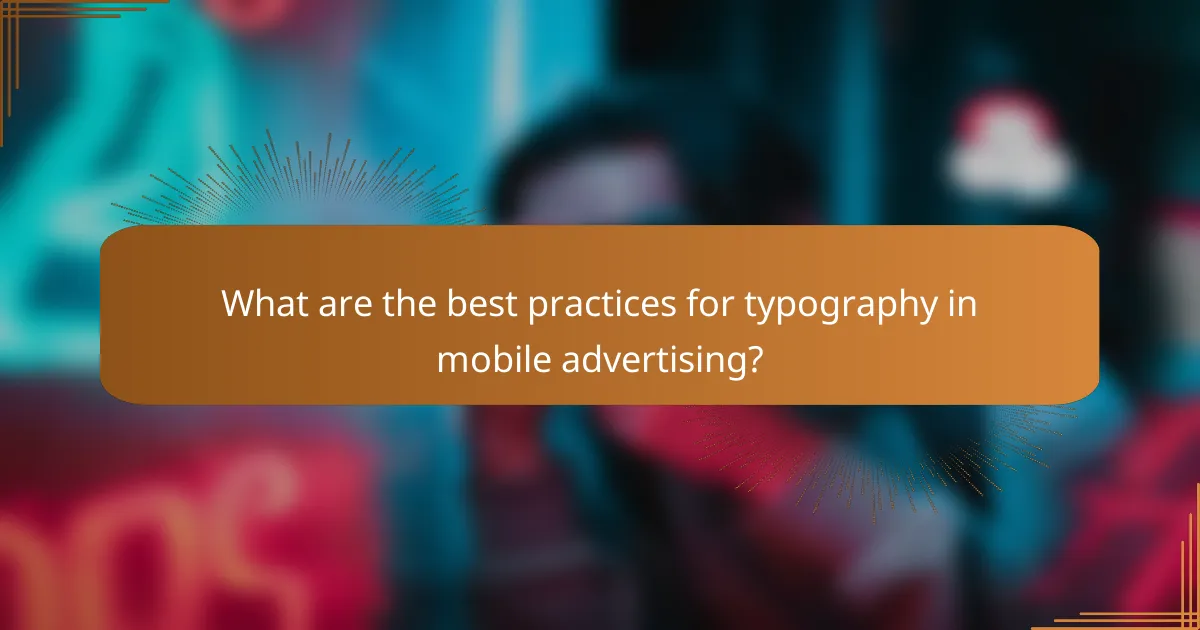
What are the best practices for typography in mobile advertising?
Best practices for typography in mobile advertising focus on enhancing readability and ensuring brand consistency. Key elements include using legible fonts, maintaining appropriate sizes, and ensuring that text contrasts well with backgrounds to capture attention effectively.
Responsive design considerations
Responsive design is crucial for typography in mobile advertising, as it ensures that text displays well across various screen sizes. Use fluid typography that scales appropriately, typically ranging from 16px to 24px for body text, depending on the device. This adaptability helps maintain readability without compromising the overall design.
Consider using CSS media queries to adjust font sizes and line heights based on the viewport. For instance, a larger font size may be necessary for smaller screens to ensure clarity. Testing across devices is essential to achieve a consistent user experience.
Touch target sizes for accessibility
Touch target sizes are vital for accessibility in mobile advertising, as they affect how easily users can interact with text elements. A recommended minimum touch target size is around 44×44 pixels, which allows users to tap links or buttons without frustration. This is especially important for mobile users who may be using their fingers to navigate.
Ensure that text links are not only legible but also adequately spaced to prevent accidental clicks. Avoid placing clickable text too close together, as this can lead to user errors. Regularly review your designs against accessibility guidelines to enhance usability for all users.
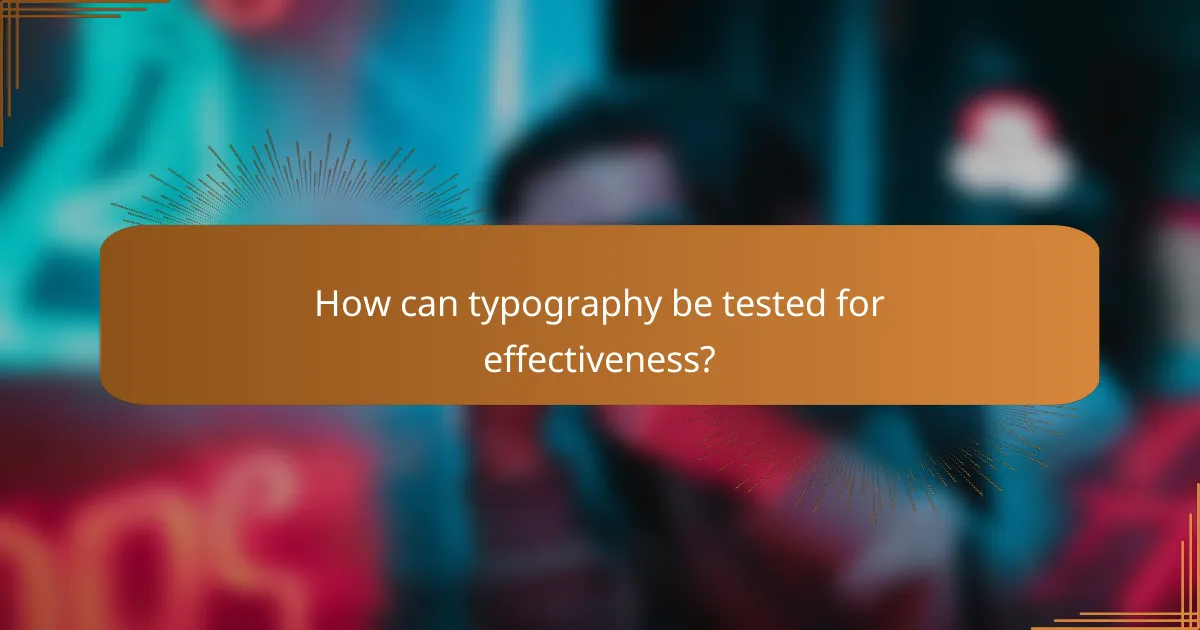
How can typography be tested for effectiveness?
Typography can be tested for effectiveness by assessing its readability, style, and alignment with brand voice. This involves evaluating font choices, sizes, spacing, and overall design to ensure they enhance user experience and convey the intended message.
Readability Testing
Readability testing focuses on how easily text can be read and understood. Common methods include using readability formulas like the Flesch-Kincaid score, which considers sentence length and syllable count. Aim for a score that aligns with your target audience’s reading level, typically between 60-80 for general content.
Consider conducting user tests where participants read sample texts and provide feedback on clarity and ease of understanding. Observing how long it takes users to read and comprehend the material can also provide valuable insights.
Style Consistency
Style consistency ensures that typography aligns with your brand’s visual identity. This includes using a limited number of fonts, maintaining uniform sizes, and adhering to a specific color palette. Establishing a style guide can help maintain this consistency across all platforms.
Evaluate your typography by comparing it against established brand guidelines. If your brand voice is modern and clean, choose sans-serif fonts and avoid overly decorative styles that may detract from the message.
Brand Voice Alignment
Typography should reflect your brand voice, whether it’s professional, playful, or innovative. Choose fonts that resonate with your target audience and convey the right emotions. For instance, a tech company may opt for sleek, modern fonts, while a children’s brand might choose playful, rounded typefaces.
Test different typographic styles with your audience to see which resonates best. A/B testing can be effective here; present different typography options and analyze user engagement metrics to determine which aligns best with your brand voice and audience preferences.

